Top Trends in Educational Technology Shaping the Future of Digital Learning

EdTech has become the essential infrastructure powering modern education. While the pace of innovation is increasing exponentially, the 2025 market demands strategic navigation through significant headwinds.
The post-pandemic reality has hit the sector hard: U.S. EdTech funding has dropped 86% since 2021 (source), with layoffs sweeping mid-sized players. Yet demand for transformative learning experiences keeps climbing, forcing smarter innovation over raw growth.

Key technologies are driving this pivot. AI personalization engines can customize every student interaction, immersive VR environments transport learners beyond physical boundaries, gamified platforms boost engagement through competitive mechanics, and adaptive microlearning delivers knowledge precisely when needed.
While these emerging EdTech trends keep companies competitive despite market consolidation, talent scarcity makes traditional scaling impossible. Education providers increasingly adopt flexible strategies like offshore IT staff augmentation to help maintain velocity while avoiding the slowdowns caused by traditional hiring.
Our analysis examines current trends in educational technology delivering real impact in 2025. We've identified which education technology trends matter, which are only hype, and which need more time to fully develop — whether you're building for K-12, higher education, or corporate training.
The Evolution and Impact of EdTech in Modern Education
Educational technology is facing a pivotal transformation. The post-pandemic reality is one of stark contrasts: global investment in online education companies crashed to $3 billion in 2024 from the $17.3 billion peak in 2021 (source). This shift signals a pivot by investors toward more sustainable, impact-driven solutions and away from growth-at-all-costs models.
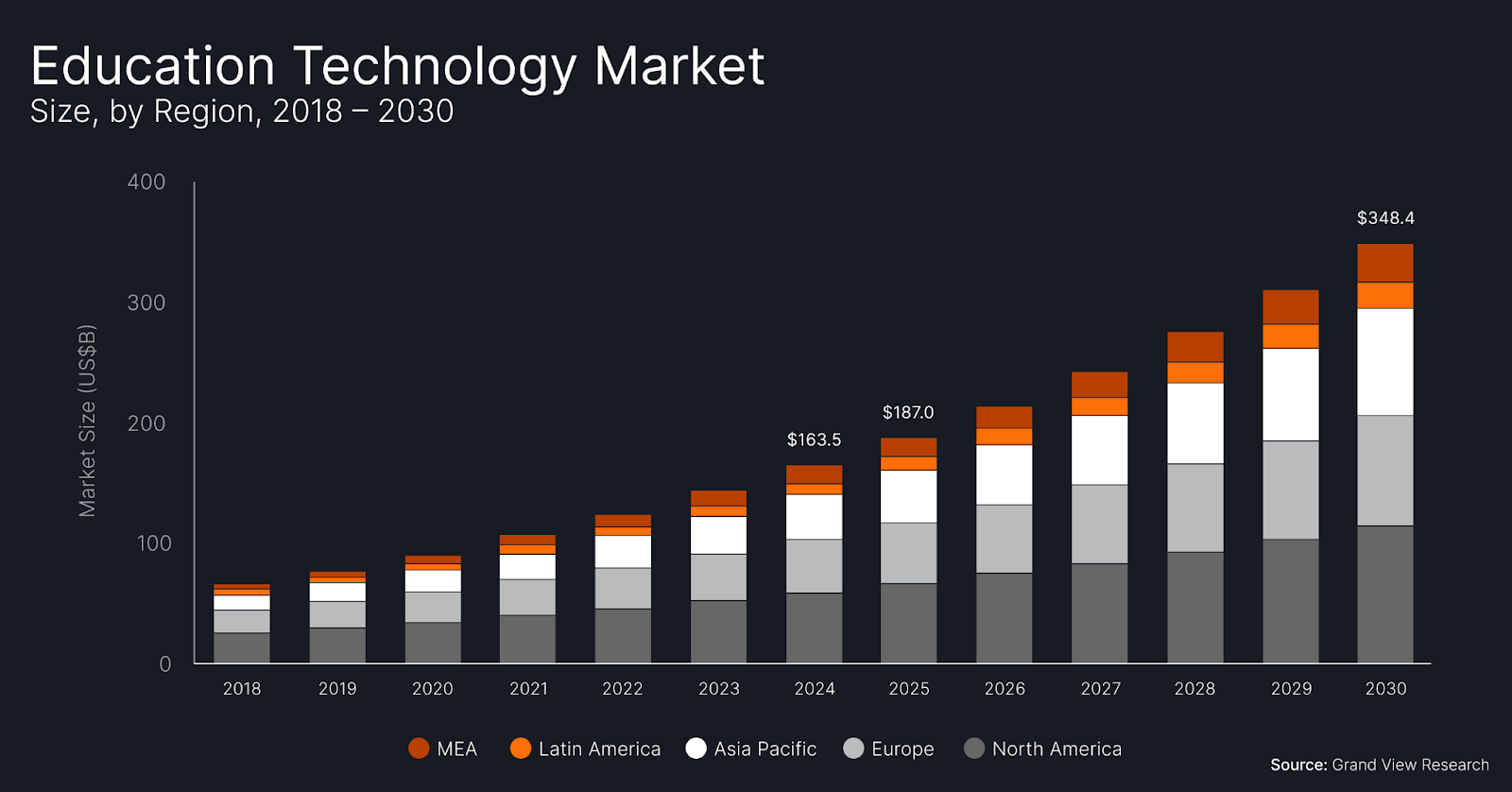
Market fundamentals remain strong despite funding compression. The global EdTech market reached $163.5 billion in 2024 and is projected to surpass $348 billion by 2030, maintaining a CAGR of 13.3% (source). Artificial intelligence, virtual reality, and emerging interactive technologies are expected to fuel this expansion by fundamentally changing how students engage with learning platforms.
These latest trends in educational technology will reshape digital learning beyond simple digitization. The following innovations we discuss demonstrate how education technology trends create competitive advantages for institutions while transforming student outcomes.
From Chalkboards to AI: EdTech's Rapid Evolution
Educational technology has developed from static tools to more dynamic systems. Late-twentieth-century classrooms relied on chalkboards and overhead projectors that enforced one-way instruction and rigid pacing for all students.
In the 1990s, computers were becoming common in schools, launching early educational technology trends. Word processors and CD-ROMs diversified content delivery, while dial-up internet enabled primitive e-learning. While foundational to modern EdTech, these remained disconnected tools rather than integrated learning environments.
Learning management systems (LMSs) transformed education in the 2000s. Moodle and Blackboard centralized resources, assignments, and communication, laying the groundwork for more advanced digital learning ecosystems. In the 2010s, cloud infrastructure enabled online learning, which accelerated during the COVID-19 pandemic.
Today's AI-powered era transcends content digitization. Machine learning algorithms personalize student interactions. Natural language processing enables conversational tutoring. Real-time learning analytics adjust content based on performance. These technology trends in education create genuinely personalized learning experiences at scale.
Current EdTech trends reflect this fundamental shift. Intelligent, responsive, and immersive learning platforms transform how students engage, teachers deliver, and institutions operate. Learning is no longer constrained to the classroom, but can reach students wherever they are.
Why EdTech Matters More Than Ever in 2025
EdTech has become an essential part of education’s infrastructure. Rising student expectations and mounting educator demands require scalable, data-driven solutions that improve outcomes without exploding budgets.
Current education technology trends address this reality head-on. AI engines personalize instruction for millions of learners. Adaptive learning systems close achievement gaps through targeted interventions. Immersive tools engage students across demographics and geographies. These aren't luxury features anymore; they're baseline requirements.
The talent crisis compounds these challenges. AI and cloud engineering roles face 15% vacancy rates across U.S. EdTech companies, delaying product launches and innovation cycles (source). When speed determines market position, talent gaps become existential threats. Smart companies leverage IT staff augmentation services to help reinforce development capacity without traditional hiring delays.

Today's EdTech trends reflect pure business necessity. Education providers have to deliver personalized, measurable learning experiences at unprecedented scale and velocity. Modern learning platforms make this possible through intelligent automation, real-time analytics, and flexible architecture. The competitive landscape rewards those who ship transformative learning experiences fastest.
Key Factors Shaping Technology Trends in Education
Today's education technology trends are emerging from changing expectations among learners as much as from increasing technological capabilities. Five forces drive current innovation:
- Students demand personalized, interactive learning experiences
- Institutions require scalable infrastructure spanning K-12 as well as higher education
- AI/ML breakthroughs enable real-time adaptive learning and predictive analytics
- Hybrid and asynchronous models allow continuous learning even when school buildings are closed
- Tech talent is critical to system maintenance, but shortages plague education development teams
These pressures force EdTech companies to go beyond feature updates and into architectural overhauls. Smart product design, flexible team structures, and measurable outcome delivery separate market leaders from legacy players.
Read more: Key Steps to Building a Tech Team
AI-Powered Educational Technology for Personalized Learning
Artificial intelligence has become the core engine powering many modern learning platforms. Its adaptive algorithms customize student journeys, and predictive assessments identify struggling learners before they fall behind. AI enables a degree of personalization previously impossible at institutional scale.
The numbers prove the transformation: 86% of educators say that AI and related technologies need to be fully integrated into teaching environments (source). This technology addresses mounting demands for flexibility, instant feedback, and truly personalized learning paths.
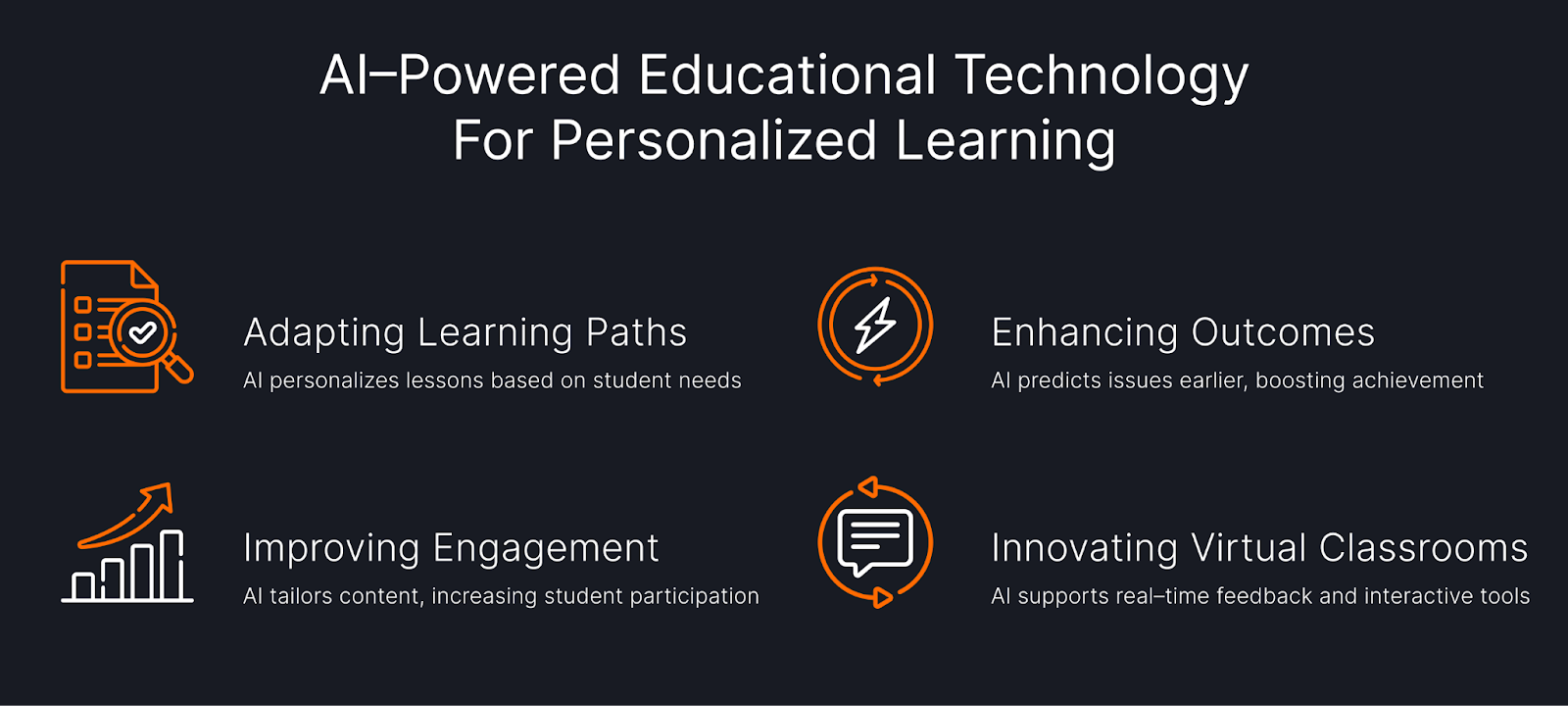
Benefits of AI in Adapting Learning Paths
AI makes individualized education scalable. Modern learning platforms continuously assess progress, dynamically adjust content difficulty, and serve materials matching each student's pace and comprehension level. Real-time adaptation replaces one-size-fits-all courseware.
Results validate the approach. Adaptive learning systems boost student performance up to 30% versus traditional digital tools (source). Dynamic learning paths increase engagement, reduce dropout rates, and improve mastery, particularly for skill-building and test preparation platforms. EdTech providers leveraging AI create superior student outcomes.
Role of Machine Learning in Education Technology
Machine learning quietly revolutionizes learning platform operations. ML algorithms automate assessments, identify knowledge gaps, and optimize the learning process continuously without human intervention. These capabilities define emerging education technology trends.
ML excels at clustering student behaviors, predicting outcomes, and recommending personalized content across thousands of simultaneous users. EdWeek reports that 43% of K-12 educators reported receiving at least one AI-related training session in 2024. The message for EdTech leaders: platforms that learn from user behavior dominate those that don't, but there may be a knowledge gap that inhibits effective implementations.
How AI Enhances Student Engagement and Outcomes
AI transforms engagement through intelligent intervention. Real-time tutoring chatbots answer questions instantly. Algorithms detect struggling students before they quit. Personalized nudges maintain motivation during challenging content.
These AI-powered tools reduce dropout rates by 20% in self-paced learning environments when combined with gamification and micro-assessments (source). Higher engagement translates directly to improved completion rates, stronger reviews, and increased platform retention for EdTech providers.
Use Cases of AI in Virtual Classrooms
AI functions as an invisible teaching assistant in digital learning environments. Smart systems track participation, provide instant accessibility features, and alert instructors to at-risk students before problems escalate.
Educational technology trends use AI to:
- Automate moderation ensuring productive discussions
- Create real-time transcriptions and translations breaking language barriers
- Use predictive analytics to flag disengagement patterns
- Adjust content dynamically based on learning analytics
Platforms like Squirrel AI and Carnegie Learning demonstrate this power through real-time content adjustment and personalized feedback loops. These systems help educators support more students while maintaining their ability to give students individual attention. In hybrid learning environments, AI becomes essential infrastructure for scaling excellence.
Immersive Learning Through VR and AR Technologies
While AI personalizes learning paths, VR and AR transform how knowledge feels and sticks. These immersive technologies enable students to explore ancient civilizations, perform virtual surgeries, and manipulate complex molecules in three-dimensional space.
Market demand validates the shift. AR/VR in education is projected to reach $116.6 billion by 2035, growing at a CAGR of 15.7% (source). This explosive growth reflects proven educational impact, not technological novelty.
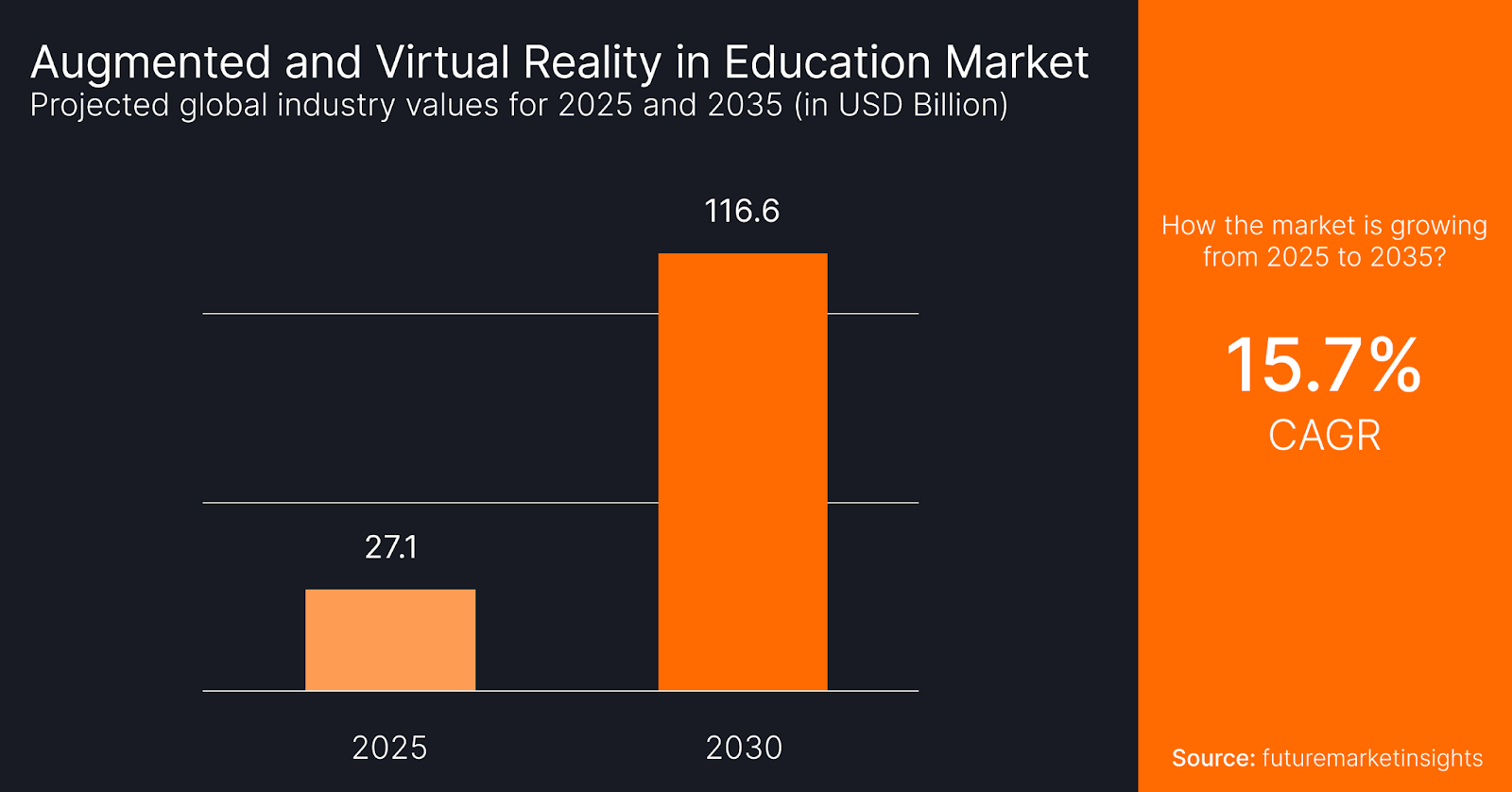
Immersive learning delivers measurable advantages through experiential engagement. Students retain what they experience far better than what they read. Virtual dissections replace preserved specimens. Historical tours transport learners across centuries. Risk-free simulations prepare medical students for real procedures. These interactive experiences fundamentally change how students grasp complex concepts.
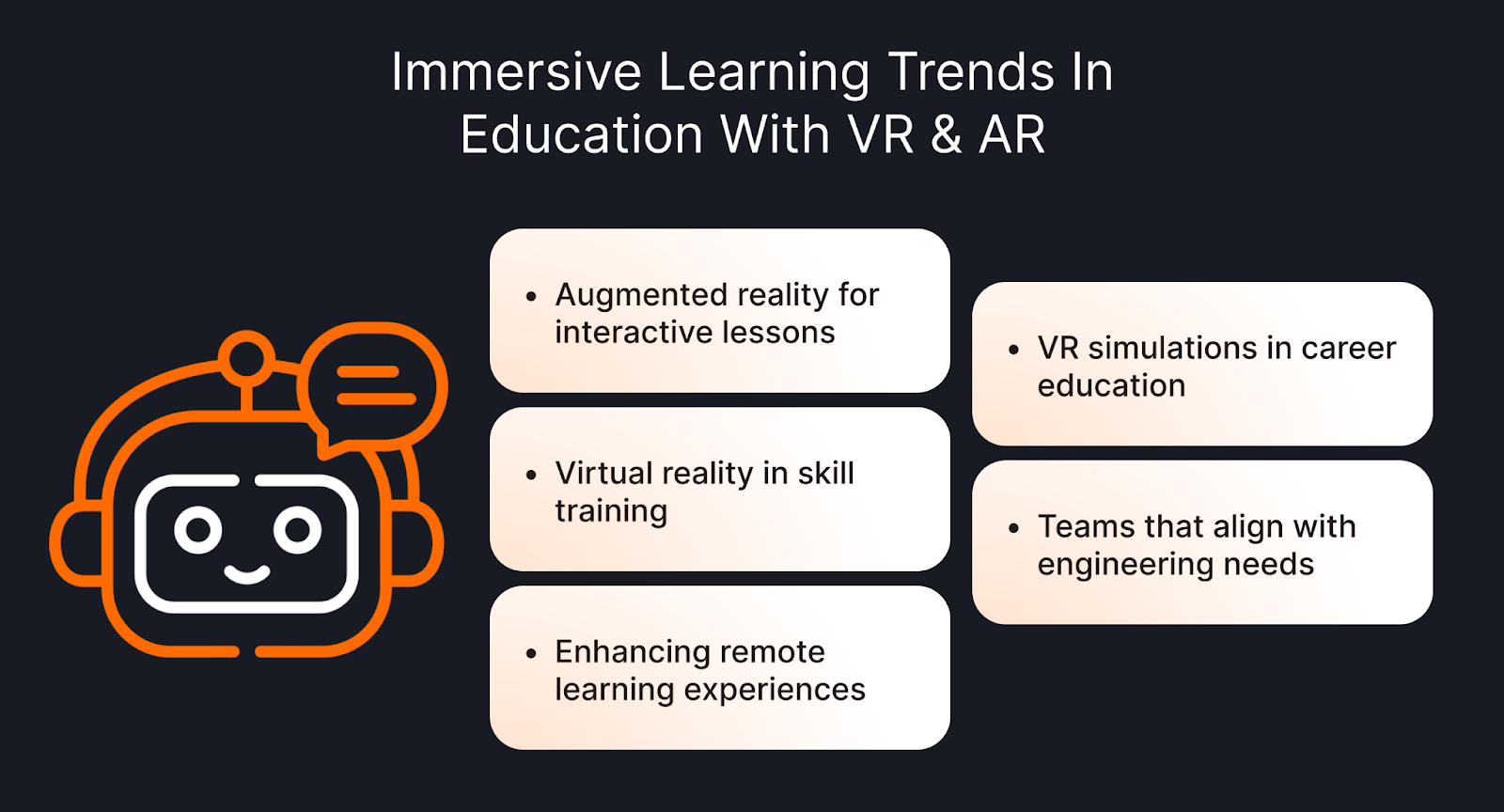
Transforming Classrooms Through Augmented Reality
AR converts passive content consumption into active exploration without expensive equipment or logistics. Educational overlays transform any space into an interactive learning environment, allowing students to visualize molecular structures floating above their desks, historical figures to appear in classroom corners, and abstract mathematical concepts to be made into manipulable 3D objects.
Research confirms the impact: AR-enhanced lessons improve knowledge retention by 25% versus traditional methods (source). This isn't about flashy effects; it's about making abstract concepts tangible for diverse learning styles.
EdTech developers embedding lessons with AR capabilities create powerful competitive advantages. Instead of simply reading content in a textbook, students can interact with it, manipulate it, and remember it. Platforms delivering these immersive learning experiences capture engagement metrics that traditional courseware cannot match.
Virtual Reality for Skill-Based Learning Environments
VR transforms theoretical knowledge into practical expertise, allowing nursing students to perfect clinical procedures without patient risk, and enabling engineers to manipulate complex machinery in safe virtual environments. This technology converts abstract concepts into muscle memory through repeated practice.
The results prove transformative: VR-trained learners complete tasks with up to 275% more confidence than traditionally trained peers (source). This confidence translates directly to real-world performance, making VR essential for job-aligned education programs.
EdTech platforms integrating VR with personalized learning paths and real-time feedback create unmatched competitive advantages. Students don't just learn; they practice until mastery becomes automatic.
Advantages of Immersive Learning for Remote Students
Immersive technologies eliminate distance barriers in digital learning. Virtual labs replace physical equipment, AR overlays transform home spaces into interactive classrooms, and 3D simulations turn flat video calls into engaging experiences regardless of student location.
Research confirms immersive tools increase focus and reduce multitasking during remote sessions. Students stay engaged longer, absorb more content, and achieve better outcomes. For distributed learning environments, these technologies transform from nice-to-have features into essential infrastructure.
Real-World Applications Across Education Levels
Leading institutions already deploy immersive learning at scale. For example, Lincoln Middle School uses AR apps to help students visualize STEM concepts through interactive exploration. And Arizona State University replaced traditional cadaver labs with VR anatomy simulations, reducing costs while boosting engagement.
K-12 implementations focus on making abstract concepts tangible: chemical reactions students can manipulate, historical events they can witness, mathematical principles they can touch. Higher education uses VR for professional training: medical procedures, engineering simulations, public speaking practice in virtual auditoriums.
These applications establish new benchmarks for student engagement and skill development. Immersive technologies don't just represent emerging EdTech trends; they define the future standard for effective education delivery.
Current Trends in Microlearning and Blended Education Models
Microlearning and blended education models dominate current EdTech trends by matching how modern learners consume content. These approaches replace marathon lectures with bite-sized, flexible modules that deliver better outcomes in less time.
The data proves the shift: microlearning boosts retention rates by 80% through spaced repetition and immediate application (source). Blended classrooms combining online and in-person elements consistently outperform traditional instruction. These aren't incremental improvements; they represent fundamental changes in educational delivery.
Students demand learning that fits their schedules, devices, and pace. Microlearning delivers targeted concepts exactly when needed. Blended models provide scalable structure without rigidity. Together, they're reshaping education from the ground up.

What Makes Microlearning Effective in the Digital Age
Microlearning mirrors modern content consumption patterns. Five-minute videos replace hour-long lectures. Interactive quizzes reinforce single concepts. Flashcard apps enable practice during commutes. This approach aligns with how students already engage with digital content daily.
Cognitive science validates the method. Spaced learning chunks improve long-term retention over massed practice, and mobile-first delivery enables learning anywhere. These factors make microlearning essential for education technology trends, particularly in corporate training and skill development platforms.
Benefits of Blended Learning for Diverse Learning Styles
Blended models combine classroom structure with digital flexibility, accommodating learning preferences. Visual learners can access video content, social learners can engage in group discussions, while independent students can progress at their own pace. This adaptability drives superior outcomes across diverse student populations.
Blended learning delivers measurable advantages:
- Multiple content formats boost engagement across learning styles
- Self-paced progression supports struggling and advanced students equally
- Hybrid collaboration tools enhance both digital and in-person teamwork
- Learning analytics provide unprecedented progress visibility
- Real-time feedback enables immediate intervention when needed
EdTech platforms supporting blended models create competitive advantages through flexibility without sacrificing educational rigor.
Strategies for Implementing Microlearning Modules
Effective microlearning requires strategic design beyond content chunking. Leading EdTech platforms deploy these proven approaches:
- Single-concept focus: Each module targets one specific learning outcome, preventing cognitive overload
- Interactive delivery: Flashcards, quizzes, and simulations outperform passive video by 40% in retention metrics
- Workflow integration: Embedding modules directly into Slack, Teams, or mobile apps triples completion rates
- Outcome measurement: Instead of tracking views or clicks, real comprehension and application are measured
Smart microlearning implementations accelerate skill acquisition, boost retention, and enable flexible learning paths, particularly for corporate upskilling initiatives.
Tools and Technologies Supporting Hybrid Learning
Hybrid learning needs a technology infrastructure that bridges physical and digital environments. The right stack enables unified experiences regardless of location.
Essential technologies powering current trends in EdTech include:
- Modern LMS platforms: Canvas and Moodle centralize content, assessments, and communications
- Collaboration tools: Zoom, Teams, and Miro enable real-time interaction across modalities
- Interactive content systems: Nearpod and Genially transform static lessons into dynamic experiences
- Analytics dashboards: Track engagement and outcomes across synchronous and asynchronous sessions
The goal: deliver unified learning experiences through multiple channels. Proper infrastructure makes hybrid learning an enhancement, not a compromise.
Gamification and Edutainment Transforming Student Engagement
Gamification delivers measurable engagement improvements by integrating game mechanics into learning platforms to create experiences that feel like structured play rather than traditional coursework.
Results validate the approach: gamified learning increases student motivation by 48% while boosting retention and completion rates over 30% (source). These aren't marginal gains; they're transformative outcomes.
Emerging ed tech trends like leveling systems, achievement badges, and competitive leaderboards allow EdTech builders to create student experiences that feel playful and competitive. This helps students engage longer, complete more modules, and retain knowledge better. Platforms that make learning feel like gaming capture attention in ways traditional courseware cannot.
How Gamification Increases Motivation and Retention
Gamification ranks among the fastest-growing EdTech trends by tapping into core psychological drivers: challenge, progress, and reward. Students earn points, unlock levels, and complete achievements because they want to, not because assignments demand it.
The impact goes beyond engagement metrics. Students on gamified learning platforms — with features like immediate feedback loops and progressive difficulty — have shown improvements in task completion rates of around 50%, as well as notable increases in knowledge retention (source).
Successful Examples of Edutainment in Online Learning
Leading platforms blend education with entertainment through storytelling, interactivity, and emotional design. Learning becomes an experience students seek rather than endure.
Duolingo demonstrates this perfectly, engaging 130 million monthly users through streaks, leaderboards, and playful design that makes language acquisition addictive. BrainPOP transforms complex STEM concepts into animated narratives that younger students actually remember and apply.
These successes prove that education technology trends prioritizing engagement deliver superior outcomes. In K-12, early learning, and skill development, attention drives retention. Platforms that capture attention through entertainment principles outperform traditional courseware across every meaningful metric.
Game Design Elements That Boost Learning Outcomes
Effective gamification centers on progress mechanics that maintain engagement. Clear objectives, instant feedback loops, and adaptive difficulty create sustained motivation beyond initial novelty.
High-impact features include:
- Achievement systems rewarding milestone completion
- Competitive leaderboards driving peer motivation
- Quest-based challenges promoting active problem-solving
- Narrative frameworks creating emotional investment
These elements extend session times and improve retention, establishing gamification as an important component of modern education technology trends.
Data and Learning Analytics Driving EdTech Innovation
Data transforms EdTech from a content delivery system to an intelligent engagement mechanism. Personalized paths, dropout prediction, and performance optimization all depend on sophisticated learning analytics embedded throughout modern platforms.
The Importance of Data in Personalizing Education
Every interaction generates insights. Click patterns reveal comprehension gaps. Quiz timing indicates confidence levels. Session duration predicts engagement depth. Platforms that use this real-time data to adapt content delivery improve learning outcomes by 20% (source).
Learning analytics enable true personalization at scale. Systems adjusting to individual learners boost engagement while reducing dropout risk, delivering measurable value across thousands of students.
Predictive Analytics for Student Success
Predictive models identify struggling students before they begin to fail. Behavioral patterns, engagement metrics, and performance trends combine to flag intervention opportunities. Smart platforms recommend targeted support that prevents problems rather than reacting after damage occurs.
Current trends in educational technology prioritize prediction over reaction, using data to ensure student success.
Using Big Data to Improve Learning Outcomes
Big data reveals patterns invisible at a smaller scale. Aggregated across thousands of learners, behavioral data drives content optimization, instructional improvements, and curriculum refinement.
Industry leaders like Coursera use big data for continuous improvement, creating personalized learning paths that boost engagement by 40% (source). Using A/B testing to optimize video pacing and machine learning to refine content recommendations, the evidence-based iteration replaces guesswork.
Visualizing Progress Through Intelligent Dashboards
Dashboards transform raw analytics into actionable insights for students, educators, and product teams. Real-time visualization highlights friction points, shows where support is needed, and empowers learners to own their journey.
Effective dashboards balance data richness with user accessibility, enabling faster, smarter decisions across all stakeholders in the learning process.
Conclusion
EdTech developments are happening in tandem with the rising expectations of both students and educators. Today's learners demand personalized pacing, adaptive content, and genuinely engaging experiences that traditional education does not deliver.
Current trends in educational technology represent a fundamental transformation, not an incremental improvement. The latest trends in educational technology already power tomorrow's learning platforms: AI engines personalize every interaction in real-time, VR environments make abstract concepts tangible, and learning analytics enable proactive intervention before students struggle.
Technology enables transformation, but execution determines impact. Leading platforms leverage these innovations to create flexible, inclusive, and outcome-driven learning experiences. Companies building with AI, immersive tech, and data analytics today are shaping the future of education.
The competitive advantage belongs to EdTech builders who move fast, integrate emerging technologies strategically, and maintain relentless focus on student outcomes. Education technology trends point clearly forward: personalized, immersive, and intelligent learning wins.
FAQ
Below we answer some of the most frequently asked questions about current trends in educational technology.
What are the current trends in educational technology facing adoption barriers?
Integration complexity tops the list of challenges, followed by educator training gaps and equitable student access. Legacy systems resist new education technology trends, while budget constraints limit implementation scope. Success requires phased rollouts that address technical, training, and accessibility barriers systematically.
How does educational technology support inclusive learning environments?
Modern learning platforms deliver content through multiple formats, enabling students to engage based on individual needs. Adaptive learning systems adjust pacing automatically, while accessibility features like screen readers and closed captions ensure no student gets left behind. These personalized learning experiences transform education from one-size-fits-all to truly inclusive.
What role does social media play in shaping modern digital learning?
Social media mechanics revolutionize student engagement through peer collaboration, instant feedback loops, and content sharing capabilities. These interactive features make learning environments feel native to students already fluent in social platforms. The result: higher participation rates and deeper engagement with course materials.
How do EdTech solutions address emerging data privacy concerns?
Leading platforms implement enterprise-grade security protocols, maintain GDPR and COPPA compliance, and provide transparent data usage policies. Big data in education requires bulletproof protection through encryption, access controls, and clear user consent mechanisms. Parents and institutions demand nothing less.
What risks emerge from artificial intelligence in educational settings?
AI implementation carries real considerations: algorithmic bias can affect student assessments, human interaction is reduced compared to traditional classrooms, and there’s a potential to over-automate teaching processes. Responsible deployment requires human oversight, bias testing, and maintaining the essential educator-student relationship that technology should enhance, not replace.
Where are mobile learning apps heading in the education market?
Mobile-first design dominates upcoming EdTech trends, driven by student device preferences and learning flexibility demands. App development for education focuses on microlearning modules, offline capability, and seamless cross-device synchronization. The future belongs to platforms that treat mobile as primary, not secondary.
How does custom app development enable adaptive learning breakthroughs?
Purpose-built applications deliver real-time learning analytics, instant content adjustments, and granular progress tracking. These technical capabilities power truly adaptive learning systems that respond to individual student needs millisecond by millisecond. Generic platforms can't match the precision of custom-developed solutions designed for specific educational contexts.
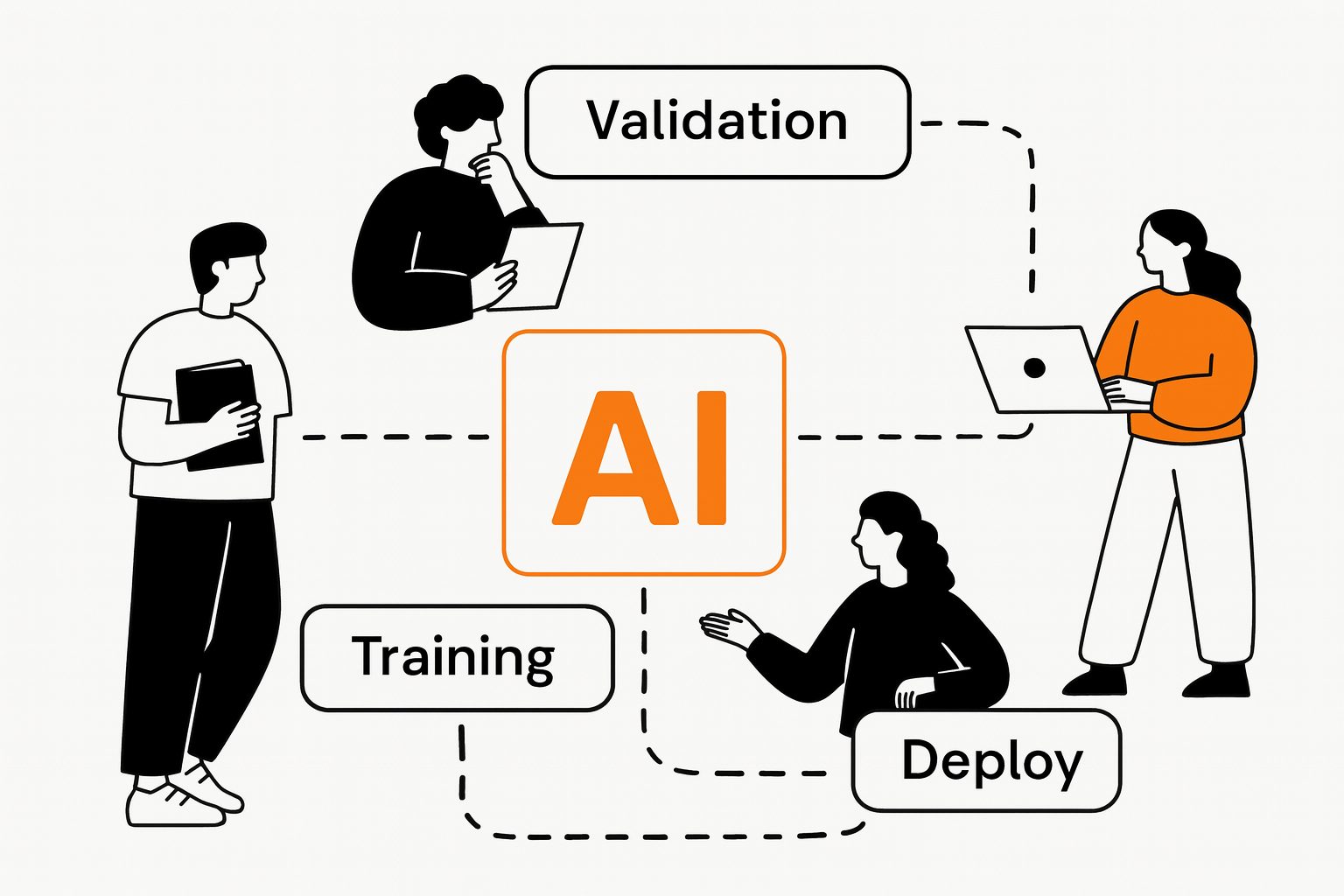
Building Successful AI-Enabled Technology Teams - A Strategic Framework for the Modern Enterprise
Discover how to build successful AI-enabled teams with proven frameworks, AI developers, and talent management strategies for modern software development.

Genius Match Strengthens Leadership Team with Industry Veterans Helen Prashchur and Elizabeth Jenkins
Genius Match announced the appointment of two seasoned sales executives to drive North American expansion.
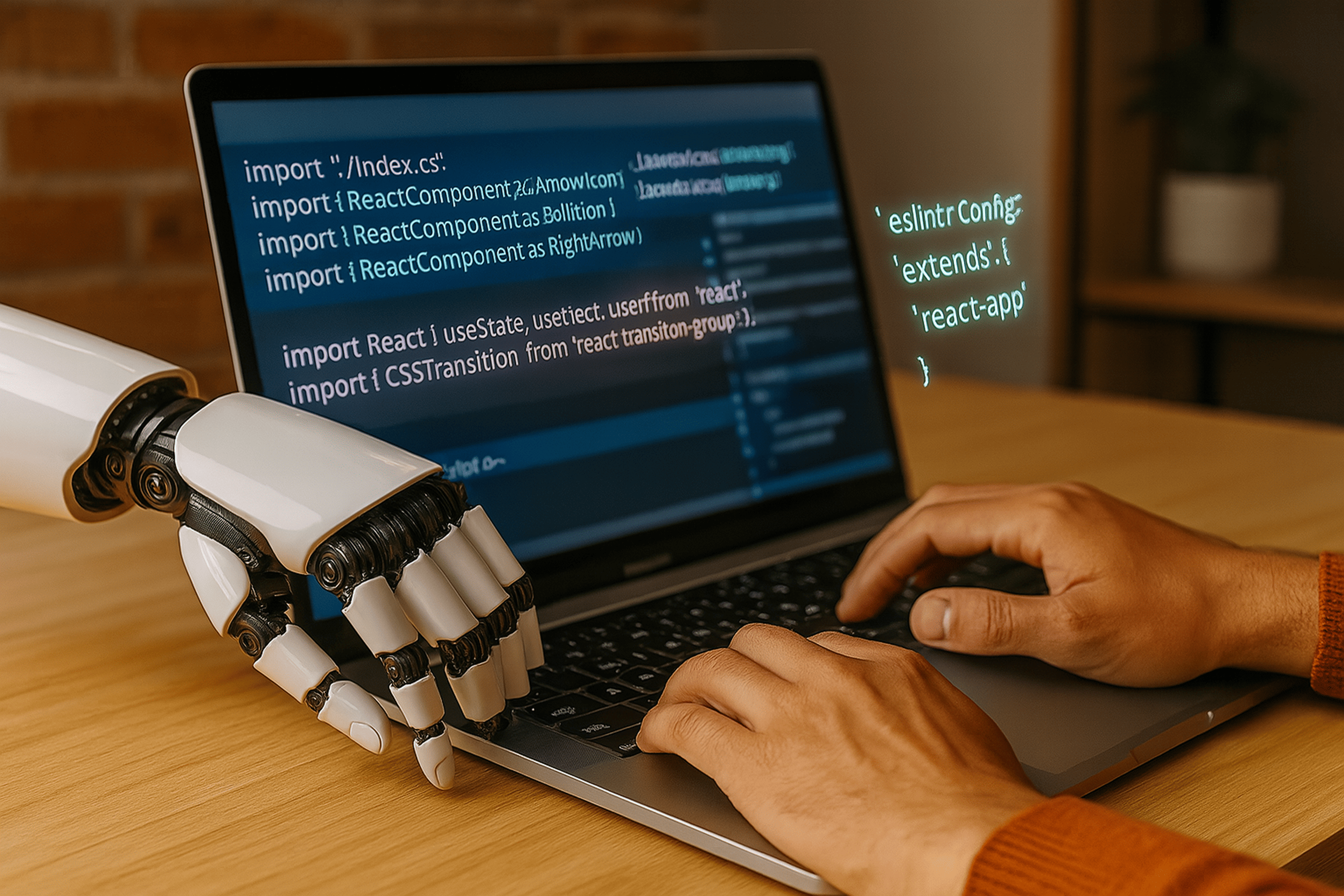
The AI-Driven Evolution of Software Development: Why Global Talent and Human Expertise Matter More Than Ever
The software development landscape has undergone a seismic shift. AI assistants now write code, automate complex tasks, and streamline development workflows in ways that seemed impossible just a few years ago. While this revolution has transformed how we build software, it has also created new challenges and misconceptions that are reshaping the entire industry.